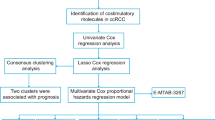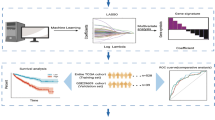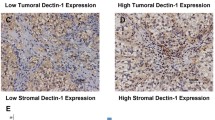Abstract
Costimulatory molecules were considered to be promising and important targets in immunotherapy for various cancers. The present study was intended for generating a costimulatory molecule signature in kidney renal clear cell carcinoma (KIRC), to investigate prognostic implication, elucidate immune atlas, and predict immunotherapy response. All the KIRC samples from the TCGA were randomly divided into the training dataset and the testing dataset in the ratio of 7:3. The Cox and least absolute shrinkage and selection operator (LASSO) regression analysis were used to identify 7 key costimulatory molecules which were associated with prognosis and construct a costimulatory molecule prognostic index (CMsPI), which was validated by internal and external datasets and an independent cohort. Patients in the high-CMsPI group had high mortality. Mutation analysis showed the most common mutational genes and variant types. Immune analysis demonstrated CD8+ T cells were infiltrated at a high level in the high-CMsPI group. In combination of analysis of the immune relevant gene signature and the biomarkers of immunotherapy, we may infer there were more dysfunctional CD8+ T cells in the high-CMsPI group, and the patients of this group were less sensitive to immunotherapy. A nomogram was constructed, and the concordance index was 0.77 (95% CI: 0.74–0.79). Three key signaling pathways were identified to facilitate tumor progression. The CMsPI can be regarded as a promising biomarker for predicting individual prognosis and assessing immunotherapy response in KIRC patients.









Similar content being viewed by others
Data availability
The data used and analyzed during the present study are available from TCGA (https://portal.gdc.cancer.gov/), GEO (https://www.ncbi.nlm.nih.gov/geo/query/acc.cgi?acc=GSE29609), Metascape (http://metascape.org/gp/index.html#/main/step1), Estimation of STromal and Immune cells in MAlignant Tumor tissues using Expression data (ESTIMATE) (https://bioinformatics.mdanderson.org/estimate/), Estimating the Proportion of Immune and Cancer cells (EPIC) (http://epic.gfellerlab.org/), Microenvironment Cell Populations-counter (MCP-counter) (http://timer.cistrome.org/), quanTIseq (http://icbi.at/quantiseq), xCell (http://xCell.ucsf.edu/), the Cancer Immunome Atlas (TCIA) (https://tcia.at/home), Tumor Immune Dysfunction and Exclusion (TIDE) (http://tide.dfci.harvard.edu), and Gene Set Enrichment Analysis (GSEA) (https://www.gsea-msigdb.org/gsea/index.jsp).
Abbreviations
- KIRC :
-
Kidney renal clear cell carcinoma
- PD1 :
-
Programmed cell death protein 1
- CMs :
-
Costimulatory molecules
- DECMs :
-
Differentially expressed costimulatory molecules
- ICOS :
-
Inducible T cell co-stimulator
- GO :
-
Gene Ontology
- KEGG :
-
Kyoto Encyclopedia of Genes and Genomes
- CMsPI :
-
Costimulatory molecules prognostic index
- LASSO :
-
The least absolute shrinkage and selection operator
- ROC :
-
The receiver operating characteristic
- ssGSEA :
-
Single sample gene set enrichment analysis
- TIDE :
-
Tumor immune dysfunction and exclusion
- TMB :
-
Tumor mutation burden
- TIICs :
-
Tumor-infiltrating immune cells
- ESTIMATE :
-
Malignant tumor tissues using expression data
- ICIs :
-
Immune checkpoints inhibitors
References
Amatore F, Gorvel L, Olive D (2020) Role of inducible co-stimulator (ICOS) in cancer immunotherapy. Expert Opin Biol Ther 20(2):141–150. https://doi.org/10.1080/14712598.2020.1693540
Aran D, Hu Z, Butte AJ (2017) xCell: digitally portraying the tissue cellular heterogeneity landscape. Genome Biol 18(1):220. https://doi.org/10.1186/s13059-017-1349-1
Becht E, Giraldo NA, Lacroix L, Buttard B, Elarouci N, Petitprez F, ... de Reyniès A (2016) Estimating the population abundance of tissue-infiltrating immune and stromal cell populations using gene expression. Genome Biol 17(1):218. https://doi.org/10.1186/s13059-016-1070-5
Burugu S, Dancsok AR, Nielsen TO (2018) Emerging targets in cancer immunotherapy. Semin Cancer Biol 52(Pt 2):39–52. https://doi.org/10.1016/j.semcancer.2017.10.001
Charoentong P, Finotello F, Angelova M, Mayer C, Efremova M, Rieder D, ... Trajanoski Z (2017) Pan-cancer immunogenomic analyses reveal genotype-immunophenotype relationships and predictors of response to checkpoint blockade. Cell Rep 18(1):248–262. https://doi.org/10.1016/j.celrep.2016.12.019
Deleuze A, Saout J, Dugay F, Peyronnet B, Mathieu R, Verhoest G, ... Kammerer-Jacquet, S-F (2020) Immunotherapy in renal cell carcinoma: the future is now. Int J Mol Sci 21(7). https://doi.org/10.3390/ijms21072532
de Miranda NF, Björkman A, Pan-Hammarström Q (2011) DNA repair: the link between primary immunodeficiency and cancer. Ann N Y Acad Sci 1246:50–63. https://doi.org/10.1111/j.1749-6632.2011.06322.x
Díaz-Montero CM, Rini BI, Finke JH (2020) The immunology of renal cell carcinoma. Nat Rev Nephrol 16(12):721–735. https://doi.org/10.1038/s41581-020-0316-3
Dostert C, Grusdat M, Letellier E, Brenner D (2019) The TNF family of ligands and receptors: communication modules in the immune system and beyond. Physiol Rev 99(1):115–160. https://doi.org/10.1152/physrev.00045.2017
Edner NM, Carlesso G, Rush JS, Walker LSK (2020) Targeting co-stimulatory molecules in autoimmune disease. Nat Rev Drug Discovery 19(12):860–883. https://doi.org/10.1038/s41573-020-0081-9
Edeline J, Mottier S, Vigneau C, Jouan F, Perrin C, Zerrouki S, ... Rioux-Leclercq N (2012) Description of 2 angiogenic phenotypes in clear cell renal cell carcinoma. Hum Pathol 43(11):1982–1990. https://doi.org/10.1016/j.humpath.2012.01.023
Escudier B, Porta C, Schmidinger M, Rioux-Leclercq N, Bex A, Khoo V, … Horwich A (2019) Renal cell carcinoma: ESMO Clinical Practice Guidelines for diagnosis, treatment and follow-up†. Ann Oncol 30(5):706–720. https://doi.org/10.1093/annonc/mdz056
Finotello F, Mayer C, Plattner C, Laschober G, Rieder D, Hackl H, ... Trajanoski Z (2019) Molecular and pharmacological modulators of the tumor immune contexture revealed by deconvolution of RNA-seq data. Genome Med 11(1):34. https://doi.org/10.1186/s13073-019-0638-6
Galon J, Bruni D (2019) Approaches to treat immune hot, altered and cold tumours with combination immunotherapies. Nat Rev Drug Discovery 18(3):197–218. https://doi.org/10.1038/s41573-018-0007-y
Giraldo NA, Becht E, Vano Y, Petitprez F, Lacroix L, Validire P, ... Sautès-Fridman C (2017) Tumor-infiltrating and peripheral blood t-cell immunophenotypes predict early relapse in localized clear cell renal cell carcinoma. Clin Cancer Res 23(15):4416–4428. https://doi.org/10.1158/1078-0432.CCR-16-2848
He Q-F, Xu Y, Li J, Huang Z-M, Li X-H, Wang X (2019) CD8+ T-cell exhaustion in cancer: mechanisms and new area for cancer immunotherapy. Brief Funct Genomics 18(2). https://doi.org/10.1093/bfgp/ely006
Jacobs J, Deschoolmeester V, Zwaenepoel K, Rolfo C, Silence K, Rottey S, ... Pauwels P (2015) CD70: An emerging target in cancer immunotherapy. Pharmacol Ther 155. https://doi.org/10.1016/j.pharmthera.2015.07.007
Janakiram M, Chinai JM, Zhao A, Sparano JA, Zang X (2015) HHLA2 and TMIGD2: new immunotherapeutic targets of the B7 and CD28 families. Oncoimmunology 4(8):e1026534. https://doi.org/10.1080/2162402X.2015.1026534
Jiang P, Gu S, Pan D, Fu J, Sahu A, Hu X, ... Liu XS (2018) Signatures of T cell dysfunction and exclusion predict cancer immunotherapy response. Nat Med 24(10):1550–1558. https://doi.org/10.1038/s41591-018-0136-1
Junker K, Ficarra V, Kwon ED, Leibovich BC, Thompson RH, Oosterwijk E (2013) Potential role of genetic markers in the management of kidney cancer. Eur Urol 63(2):333–340. https://doi.org/10.1016/j.eururo.2012.09.040
Junker K, Hindermann W, von Eggeling F, Diegmann J, Haessler K, Schubert J (2005) CD70: a new tumor specific biomarker for renal cell carcinoma. J Urol 173(6):2150–2153. https://doi.org/10.1097/01.ju.0000158121.49085.ba
Labriola MK, Zhu J, Gupta RT, McCall S, Jackson J, Kong EF, ... Zhang T (2020) Characterization of tumor mutation burden, PD-L1 and DNA repair genes to assess relationship to immune checkpoint inhibitors response in metastatic renal cell carcinoma. J Immunother Cancer 8(1). https://doi.org/10.1136/jitc-2019-000319
Leite KRM, Reis ST, Junior JP, Zerati M, Gomes DDO, Camara-Lopes LH, Srougi M (2015) PD-L1 expression in renal cell carcinoma clear cell type is related to unfavorable prognosis. Diagn Pathol 10:189. https://doi.org/10.1186/s13000-015-0414-x
Ljungberg B, Albiges L, Abu-Ghanem Y, Bensalah K, Dabestani S, Fernández-Pello S, … Bex A (2019) European Association of Urology Guidelines on Renal Cell Carcinoma: the 2019 update. Eur Urol 75(5):799–810. https://doi.org/10.1016/j.eururo.2019.02.011
McCall KD, Muccioli M, Benencia F (2020) Toll-like receptors signaling in the tumor microenvironment. Adv Exp Med Biol 1223:81–97. https://doi.org/10.1007/978-3-030-35582-1_5
McKinney EF, Smith KG (2016) T cell exhaustion and immune-mediated disease-the potential for therapeutic exhaustion. Curr Opin Immunol 43:74–80. https://doi.org/10.1016/j.coi.2016.09.005
Moch H, Cubilla AL, Humphrey PA, Reuter VE, Ulbright TM (2016) The 2016 WHO Classification of Tumours of the Urinary System and Male Genital Organs-part A: renal, penile, and testicular tumours. Eur Urol 70(1). https://doi.org/10.1016/j.eururo.2016.02.029
Newman AM, Liu CL, Green MR, Gentles AJ, Feng W, Xu Y, ... Alizadeh AA (2015) Robust enumeration of cell subsets from tissue expression profiles. Nat Methods 12(5):453–457. https://doi.org/10.1038/nmeth.3337
O’Neill RE, Cao X (2019) Co-stimulatory and co-inhibitory pathways in cancer immunotherapy. Adv Cancer Res 143:145–194. https://doi.org/10.1016/bs.acr.2019.03.003
Racle J, de Jonge K, Baumgaertner P, Speiser DE, Gfeller D (2017) Simultaneous enumeration of cancer and immune cell types from bulk tumor gene expression data. eLife 6. https://doi.org/10.7554/eLife.26476
Sánchez-Gastaldo A, Kempf E, González Del Alba A, Duran I (2017) Systemic treatment of renal cell cancer: a comprehensive review. Cancer Treat Rev 60:77–89. https://doi.org/10.1016/j.ctrv.2017.08.010
Sharpe AH (2009) Mechanisms of costimulation. Immunol Rev 229(1). https://doi.org/10.1111/j.1600-065X.2009.00784.x
Sharpe AH, Abbas AK (2006) T-cell costimulation–biology, therapeutic potential, and challenges. N Engl J Med 355(10):973–975. https://doi.org/10.1056/NEJMp068087
Sharpe AH, Pauken KE (2018) The diverse functions of the PD1 inhibitory pathway. Nat Rev Immunol 18(3):153–167. https://doi.org/10.1038/nri.2017.108
Siegel RL, Miller KD, Jemal A (2020) Cancer statistics, 2020. CA Cancer J Clin 70(1). https://doi.org/10.3322/caac.21590
Subramanian A, Tamayo P, Mootha VK, Mukherjee S, Ebert BL, Gillette MA, ... Mesirov JP (2005) Gene set enrichment analysis: a knowledge-based approach for interpreting genome-wide expression profiles. Proc Natl Acad Sci USA 102(43):15545–15550. https://doi.org/10.1073/pnas.0506580102
Sung H, Ferlay J, Siegel RL, Laversanne M, Soerjomataram I, Jemal A, Bray F (2021) Global Cancer Statistics 2020: GLOBOCAN estimates of incidence and mortality worldwide for 36 cancers in 185 countries. CA Cancer J Clin 71(3):209–249. https://doi.org/10.3322/caac.21660
Thompson RH, Dong H, Lohse CM, Leibovich BC, Blute ML, Cheville JC, Kwon ED (2007) PD-1 is expressed by tumor-infiltrating immune cells and is associated with poor outcome for patients with renal cell carcinoma. Clin Cancer Res 13(6):1757–1761. https://doi.org/10.1158/1078-0432.CCR-06-2599
Waldman AD, Fritz JM, Lenardo MJ (2020) A guide to cancer immunotherapy: from T cell basic science to clinical practice. Nat Rev Immunol 20(11):651–668. https://doi.org/10.1038/s41577-020-0306-5
Yarchoan M, Hopkins A, Jaffee EM (2017) Tumor mutational burden and response rate to PD-1 inhibition. N Engl J Med 377(25):2500–2501. https://doi.org/10.1056/NEJMc1713444
Yoshihara K, Shahmoradgoli M, Martínez E, Vegesna R, Kim H, Torres-Garcia W, ... Verhaak RGW (2013) Inferring tumour purity and stromal and immune cell admixture from expression data. Nat Commun 4:2612. https://doi.org/10.1038/ncomms3612
Zhou Y, Zhou B, Pache L, Chang M, Khodabakhshi AH, Tanaseichuk O, ... Chanda SK (2019) Metascape provides a biologist-oriented resource for the analysis of systems-level datasets. Nat Commun 10(1):1523. https://doi.org/10.1038/s41467-019-09234-6
Acknowledgements
We greatly appreciate the TCGA program, GEO database, ESTIMATE database, Estimating the Proportion of Immune and Cancer cells (EPIC) database, Microenvironment Cell Populations-counter database, quanTIseq database, xCell database, the Cancer Immunome Atlas (TCIA) database and Tumor Immune Dysfunction and Exclusion (TIDE) database for providing the open-source data, and thanks for Metascape and Gene Set Enrichment Analysis (GSEA) for online analysis.
Author information
Authors and Affiliations
Contributions
Conception and design: GL, YJN, and GTL. Data collection: GTL, YYY, QFF, FFZ, and CNS. Data analysis and interpretation: GTL, YYY, QFF, FFZ, and CNS. Manuscript writing: GTL, YYY, QFF. Final approval of manuscript: all the authors.
Corresponding authors
Ethics declarations
Ethics approval and consent to participate
The study protocols were approved by the Ethical Committee Review Board of the Second Hospital of Tianjin Medical University (Tianjin, China). All the participants provided written informed consent.
Conflict of interest
The authors declare no competing interests.
Additional information
Publisher's Note
Springer Nature remains neutral with regard to jurisdictional claims in published maps and institutional affiliations.
Supplementary Information
Below is the link to the electronic supplementary material.
Rights and permissions
About this article
Cite this article
Lin, G., Yang, Y., Feng, Q. et al. Prognostic implication and immunotherapy response prediction of a costimulatory molecule signature in kidney renal clear cell carcinoma. Immunogenetics 74, 285–301 (2022). https://doi.org/10.1007/s00251-021-01246-1
Received:
Accepted:
Published:
Issue Date:
DOI: https://doi.org/10.1007/s00251-021-01246-1




